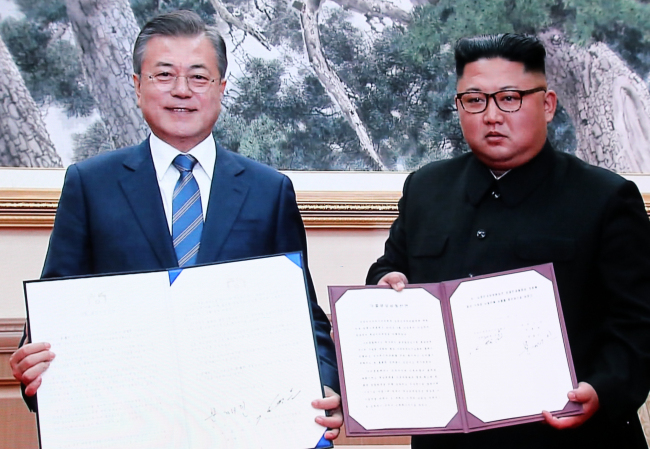
One of South Korea’s main goals entering the summit had been to spur the stalled denuclearization talks between Washington and Pyongyang.
“We believe that the talks between North Korea and the US could be accelerated based on the results of this summit, and we also hope that the talks will be held as soon as possible,” said National Security Office chief Chung Eui-yong. He added that a North Korean leader publicly expressing his intent to permanently dismantle a symbolic facility like Yongbyun has a significant meaning.
In addition, South Korean Defense Minister Song Young-moo and his counterpart No Kwang-chul signed a military agreement that centers on preventing border conflicts. South Korean presidential office called it “a de facto non-aggression pact,” which includes establising a buffer zone and a no-fly zone in the Demilitarized Zone.
“We’ve adopted a military agreement to end the decades of desperate, tragic history of hostility (between the Koreas), and pledged to make Joseon (Korean) peninsula a land of peace without nuclear weapons or nuclear threats,” said North Korea’s Kim after signing the Pyongyang Declaration.
He went on to say that he had pledged to visit Seoul “in the near future.” Moon elaborated by saying that this would take place within the year, barring unforeseen developments.
No North Korean leader has ever visited Seoul, though there had been talk of a visit by Kim’s father, former North Korean leader Kim Jong-il, in 2000.
The two sides also agreed to make a joint bid for the 2032 Summer Games, along with joint participation in international sporting events.
The Pyongyang Declaration also includes a Pyongyang art troupe’s performance in Seoul in October.
South and North Korea pledged to work on measures for “balanced development” of the economies, namely stepping up cross-border exchanges and economic cooperation.
They agreed to kick off joint projects to connect railways and roads across the border within the year, to resume Kumgangsan tours and to reopen the Kaesong industrial park, under the “right conditions,” mindful of economic sanctions in place against North Korea for its nuclear and ballistic missile programs.
The Park Geun-hye administration shut down the Kaesong complex in the North Korean border town of Kaesong in February 2016, as a punitive action against Pyongyang’s nuclear and missile provocations. The Kumgangsan tours were suspended in 2008 after a South Korean tourist was killed by a North Korean soldier.
Humanitarian efforts for families separated by the 1950-53 Korean War were also included in the statement, with the Koreas agreeing to open a permanent facility on Kumgangsan for family reunions in the near future. Other measures include holding video-based reunions and the exchange of video messages between separated family members.
Among other agreements included in the Pyongyang Declaration are: working to create special economic zones; cross-border cooperation for preservation of the natural habitat in the North; and cooperation in the medical field for prevention and containment of infectious diseases.
Moon wraps up his three-day trip to the North on Thursday with a visit to Paektusan with Kim Jong-un.
By Yoon Min-sik and Joint Press Corps
(minsikyoon@heraldcorp.com)





![[Graphic News] More Koreans say they plan long-distance trips this year](http://res.heraldm.com/phpwas/restmb_idxmake.php?idx=645&simg=/content/image/2024/04/17/20240417050828_0.gif&u=)